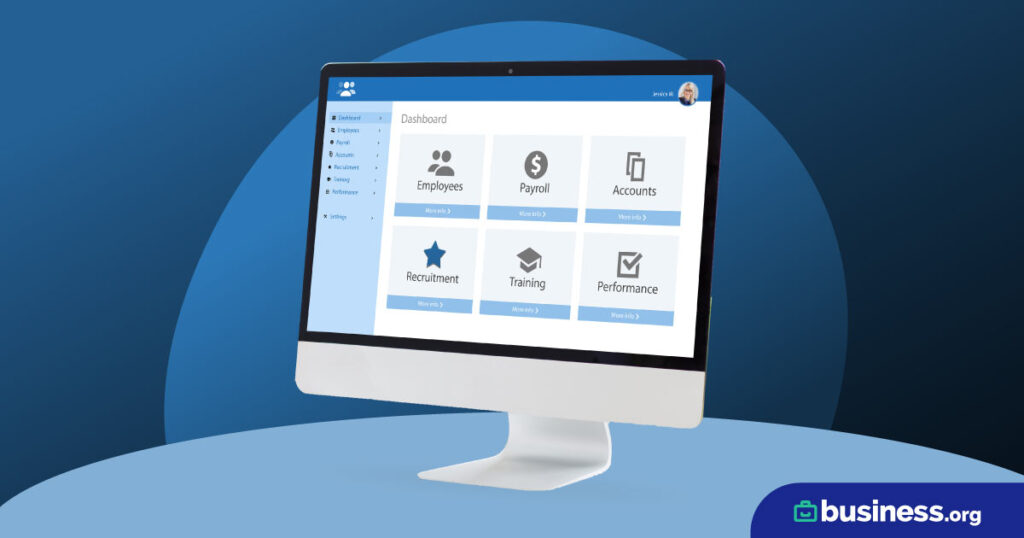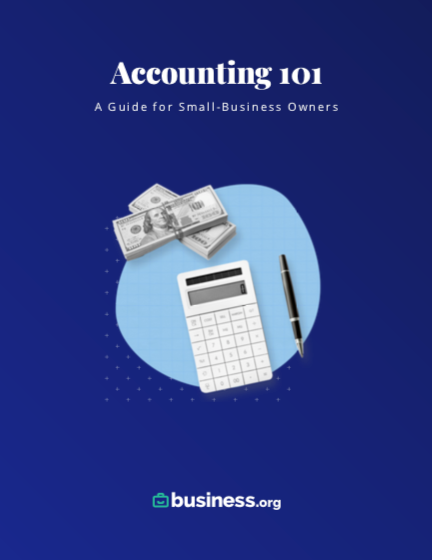We are committed to sharing unbiased reviews. Some of the links on our site are from our partners who compensate us. Read our editorial guidelines and advertising disclosure.
Accounting 101: A Guide for Small-Business Owners
So you're launching a business—congrats! But along with a rock-solid business idea, you need to chart a path to financial success by documenting, assessing, and analyzing your finances in a process known as accounting. Most small-business owners aren’t accountants, and without a background in finance, setting up an accounting system for the first time can be (understandably) overwhelming. Keep reading: our crash course in small-business accounting walks you through each step of the process.
Small-business accounting 101
1. Consult a bookkeeper, accountant, or CPA
You can learn a lot about how to do accounting for small businesses just from browsing the internet. But nothing beats up-front, personalized advice from a certified professional—in this case, a bookkeeper, accountant, or CPA. Bookkeepers, accountants, and CPAs all bring something different to the table.
- Bookkeeper: Keeps and organizes financial records. Can also handle financial tasks like payroll and invoicing.
- Accountant: Keeps and organizes financial records while providing deeper insight into your business's financial state. Can also tackle tasks like filing taxes.
- CPA (Certified Public Accountant): Accountants who have passed the Uniform Certified Public Accountant Exam, which holds accountants to more exacting standard
Some CPAs and bookkeepers require a retainer if you want monthly assistance, but many simply charge by the hour. You can pay for the advice you need and go from there.
Bookkeeping vs. accounting: What’s the difference?
People who aren't small-business accountants or often use bookkeeping and accounting interchangeably, but they actually mean two different things. Bookkeeping refers to keeping financial records. Accounting means not just keeping financial records but also analyzing and interpreting financial data so you can make wise fiscal decisions.
When should you hire a full-time bookkeeper or accountant?
Consulting part-time with a small-business bookkeeper or accountant can work nicely for newer, smaller businesses. But once your business is big enough that you can't (or simply don't want to) wrangle finances by yourself, it's probably time to get a bookkeeper or CPA on your payroll.
By signing up I agree to the Terms of Use and Privacy Policy.
2. Create a business bank account
The second you decide you’re going to launch your business, you should immediately separate your personal finances from your business finances. That means setting up a separate business bank account to handle all your small-business transactions, including a business savings account to cover your business on a rainy day.
Why is separating your financial accounts so crucial? For one, it's easier to track your business's financial progress if it isn't jumbled with your personal cash and credit. For another, it protects you legally: if your business gets sued, your personal assets can't be taken as collateral.
Looking for a business bank account? Start by learning all about how to open a business bank account, then check out our top recs for business checking and business savings accounts to find the right account for you.
Do you need a business credit card?
It can be a good idea to use a business credit card, but don't rely on it to make overdue payments or fund big purchases. Most business credit cards offer customer rewards, which can save you money on travel expenses, and paying off your business credit card's balance each month is a good way to build good credit for your business.
If you think a business credit card could benefit your business, learn how to get a credit card, then take a look at the best credit cards for small businesses.
3. Choose your accounting method (cash or accrual)
Business owners have to settle on one of two basic accounting methods before filing their first tax returns: cash-basis and accrual-basis accounting.
The accounting method you choose has a huge impact on your business, so we highly recommend you talk to your small-business accountant, CPA, or bookkeeper about which method works best for you. With that caveat in mind, here's a quick overview of the two types—and which type certain businesses are legally required to use.
Cash vs. accrual accounting
If you set up your finances with cash-basis accounting, you'll record financial transactions when the cash moves accounts.
- For instance, as soon as you pay a bill or receive an invoice, you’ll record that transaction in your financial accounts—whether or not the external company processes the payment that same day or not.
If you set up your finances with accrual-basis accounting, you'll record financial transactions when they occur, not when the money moves accounts.
- For instance, if you charge a client for repair work you finished on April 15, you'll record the income on that same date. If you received an invoice in September, you'll record it then, not when the company you owe actually processes the payment.
Most accounting software (with some notable differences) use the accrual method by default, but you can learn more about which method is right for you by talking to an accountant and reading a few more informational articles.
Compare top picks for business accounting software
Data as of 3/9/23. Offers and availability may vary by location and are subject to change.
*Only available for businesses with an annual revenue beneath $50K USD
**Current offer: 90% off for 3 mos. or 30-day free trial
†Current offer: 50% off for three months or 30-day free trial
‡Current offer: 75% off for 3 mos. Available for new customers only
4. Set up your books
Once you've settled on an accounting method, it’s time to set up your books. Here are the main questions to ask that can guide you toward creating the best bookkeeping records for your small business.
Should you choose single-entry or double-entry bookkeeping?
What method should you choose to keep your books?
There are three primary methods for keeping your books:
- Spreadsheet software like Excel or Google Sheets
- Accounting software (like QuickBooks Online or Wave Accounting)
- Bookkeeper or accountant.
Using spreadsheet software is the cheapest accounting option (especially if you use a completely free software, like Google Sheets). Hiring an in-house bookkeeper, setting up an in-house accounting team, or outsourcing your bookkeeping and accounting to a virtual provider is the most expensive accounting option, but it frees you up to focus on the business side of things (not just the financial side).
Accounting or bookkeeping software is a good middle-of-the-road option, both in terms of how much hands-on bookkeeping you want to do and how much you want to spend on accounting software. Depending on the software provider you choose and the plan you sign up for, accounting software automates most of bookkeeping's most tedious tasks, from calculating sales tax to generating easy-to-read financial reports.
Accounting software ranges in price from free to hundreds of dollars a month. And generally, no matter the plan or price, accounting software is more reliable than by-hand spreadsheet accounting.
How frequently should you update your books?
How often should you sit down with your books? As a responsible business owner, you need to record every single financial transaction you make—so the answer might depend on how many bills you pay and invoices you send out. At the very least, you'll want to sit down for bookkeeping monthly, but we strongly recommend you update your books at least weekly, though preferably daily.
5. Start recording financial transactions
You've opened a business checking account, chosen your accounting method, and decided how you're going to keep your books. Now you're ready to start recording the transactions themselves.
You'll record each transaction in a separate financial account in your general ledger. There are five primary types of accounts:
- Asset accounts, where you list everything your business owns
- Owner's equity (or shareholder equity) accounts, where you list everything you or your shareholders have invested in your business
- Liability accounts, where you list everything groups other than yourself or your shareholders have invested in your business (for instance, banks)
- Revenue accounts, where you list money your business earns by selling products or services
- Expense accounts, where you list the money your business spends to stay afloat and operational
Your CPA can advise you on which types of accounts you need. Alternatively, as you set up your accounting software, you should see a list of optional financial accounts for you to add to your chart of accounts and general ledger.
Crucial documents for accurate accounting
To make accurate journal entries and record financial transactions correctly, you need to hang on to some essential financial documents:
- Tax statements
- Receipts
- Invoices and bills
- Employee tax forms, like W-2 and 1099 forms
Most accounting software automates entering information from the documents above. For instance, receipt scanners let you take photos of receipts that you upload to your software for easy journal-entry generation. And if you send invoices or pay bills with your software, the numbers should sync automatically with your ledger.
6. Start generating financial documents
Once you have all your bookkeeping, accounting, and payroll processes set up, it’s time to start doing the actual accounting. As soon as you’ve entered financial transactions for a certain period of time—whether that’s a day, week, or month—you can use a spreadsheet template or your accounting software to generate crucial financial documents. (You can also ask your CPA or bookkeeper to create documents for you, though they should be doing that themselves without your prompting.)
The most important financial documents for any business owner who wants to understand their finances are balance sheets, cash flow statements, and income statements. You can look at these documents yourself or collaborate with a financial professional to analyze the state of your business’s finances. Our accounting tips can get you started on your way to assessing your finances.
7. Understand your tax responsibilities
And now for everyone's favorite subjects: small-business accounting and taxes.
You already know this, but just to make sure it's crystal clear, taxes are ridiculously complicated. Small-business taxes vary between industries, states, and business types, so to get the best advice on what taxes your business needs to pay, consult with your accountant. For the most part, though, you’ll probably end up paying income taxes, sales taxes, and payroll taxes.
If you’re self-employed, you'll pay self-employment taxes, which is a little different from small-business taxes and personal taxes. You can get more guidance on how to record and pay a small-business tax with your accounting software and tax professional.
The takeaway
Creating your own small business might be one of the hardest things you ever do—but we have complete confidence that you can handle it. When you stay on top of your bookkeeping and accounting processes, you empower yourself to make wise financial decisions. With these basic accounting tips for small-business owners under your belt, we’re sure you have the tools you need for small-business success.
Haven’t finished creating your business yet? Check out our guide on how to establish a small business so you can start turning a profit ASAP.
Related reading
Small-business accounting glossary
Accountant: A professional who records financial transactions, creates financial documents, analyzes financial data, and works to set financial goals.
Asset: Any resource owned by a company. An asset can be tangible, like a piece of equipment, or intangible, like a copyright.
Balance sheet: A financial document that shows your assets, liabilities, and shareholders' or owner's equity. If your business is healthy and growing, a balance sheet should show that your assets are equal to your liabilities and equity.
Bookkeeper: A professional who records financial transactions and keeps detailed financial records.
Cash flow statement: A financial document that shows all of a business's sources of cash, namely cash flow from operating, investing, and financing activities. The document also shows where that cash goes and determines if you have negative or positive cash flow. If you have negative cash flow, your business is losing money; positive cash flow means you're earning money.
Chart of accounts: A list of every financial account in your general ledger. Financial accounts include asset, liability, equity, revenue, and expense accounts.
General ledger: A collection of financial records and accounts that details a business's financial history. Information in the general ledger can be used to generate financial reports that help stakeholders make informed decisions about the business's growth and future.
Liability: Everything owed by a company (aka debts).
Profit and loss statement: A financial document that lists a business's profit and loss (including revenue, operating expenses, and non-operating expenses), also known as an income statement.
Small-business accounting checklist
Phew, you made it to the end—nicely done! Thanks for sticking with us, and best of luck to your small business. We know you're going to do great.
9 steps to successful small-business accounting
- Consult an accountant, bookkeeper, or CPA: Get expert advice on important topics like how to organize your books, what taxes you can expect to pay, and how to read important financial documents.
- Create a business bank account: Protect yourself legally and financially by setting up business checking and savings accounts and splitting your personal and business finances.
- Choose your accounting method: Get your CPA's advice on the right accounting method for your business: cash-basis or accrual-basis accounting.
- Set up your books: Decide if you want to use accounting software or work with an accountant to keep your books. Choose between single-entry bookkeeping, which is simpler, and double-entry bookkeeping, which is financially safer.
- Start recording financial transactions: Set up your general ledger and chart of accounts.
- Start generating financial documents: Create balance sheets, cash flow statements, and income statements, then analyze the data to move your business in the right direction.
- Understand your tax responsibilities: Get familiar with income, payroll, and sales tax, including the tax deadlines for each.





